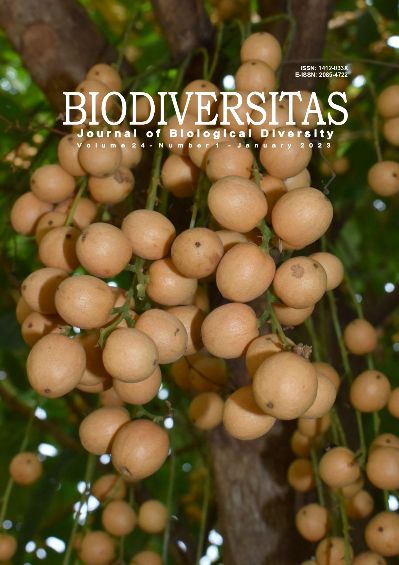Waterlogging and salinity stress affecting growth and morphological character changes of Limnocharis flava
##plugins.themes.bootstrap3.article.main##
Abstract
Abstract. Putra SP, Santosa, Salsinha YCF. 2023. Waterlogging and salinity stress affecting growth and morphological character changes of Limnocharis flava. Biodiversitas 24: 333-340. Salinity stress and waterlogging affect plant growth response. This study aims to determine the effect of variations in salinity concentration (NaCl) and water depth on the growth and morphological characters of Genjer (Limnocharis flava) plants. The study used a completely randomized design (CRD) with 5 replications with a variable depth of water (W) consisting of W0 = 0 cm from the soil surface, W1 = 5 cm from the soil surface, W2 = 10 cm from the soil surface, and treatment of variations in salt concentration. (NaCl) (S) as many as 4 levels, namely S0 = 0 ppm, S1 = 25 ppm, S2 = 50 ppm and S3 = 75 ppm. Statistical analysis with Analysis of Variance (ANOVA) showed the interaction of high NaCl concentration and higher water depth decreased wet weight, dry weight, height, length and width of leaves of L. flava. The concentration of NaCl significantly affects the growth morphology and anatomy of L. flava. The high concentration of NaCl reduced the wet weight, dry weight, height, length and width of the leaves of L. flava. The high concentration of NaCl causes changes in the anatomical structure of L. flava. Water depth significantly affects the growth morphology and anatomy of L. flava. The higher water depth reduces the wet weight, dry weight, height, length and width of the leaves of L. flava. There is an interaction between NaCl concentration and water depth. The high concentration of NaCl and high level of water depth reduced the wet weight, dry weight, height, length and width of the leaves of L. flava.
##plugins.themes.bootstrap3.article.details##
Most read articles by the same author(s)
- YUSTINA CAROLINA FEBRIANTI SALSINHA, DIDIK INDRADEWA, YEKTI ASIH PURWESTRI, DIAH RACHMAWATI, Selection of drought-tolerant local rice cultivars from East Nusa Tenggara, Indonesia during vegetative stage , Biodiversitas Journal of Biological Diversity: Vol. 21 No. 1 (2020)
- LILIH KHOTIMPERWATI, RINA SRI KASIAMDARI, SANTOSA SANTOSA, BUDI SETIADI DARYONO, Bazzania Gray (Lepidoziaceae, Marchantiophyta) in Central Java, Indonesia , Biodiversitas Journal of Biological Diversity: Vol. 19 No. 3 (2018)
- JUNITA HARDINI, RINA SRI KASIAMDARI, SANTOSA SANTOSA, PURNOMO PURNOMO, Short Communication: New records of Graphis (Graphidaceae, Ascomycota) in Bali Island, Indonesia , Biodiversitas Journal of Biological Diversity: Vol. 19 No. 1 (2018)
- YUSTINA CAROLINA FEBRIANTI SALSINHA, SITI NURBAITI, ALFINO SEBASTIAN, DIDIK INDRADEWA, YEKTI ASIH PURWESTRI, DIAH RACHMAWATI, Proline-related gene expressions contribute to physiological changes of East Nusa Tenggara (Indonesia) local rice cultivars during drought stress , Biodiversitas Journal of Biological Diversity: Vol. 23 No. 7 (2022)

